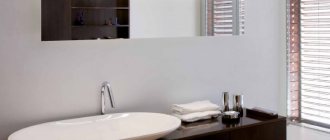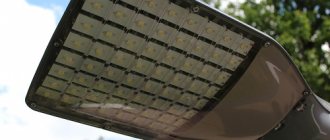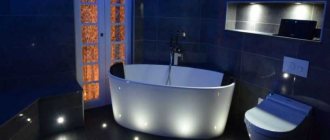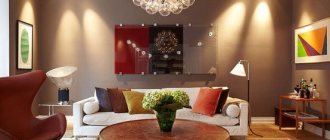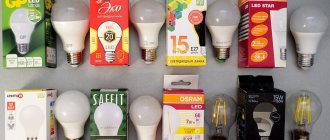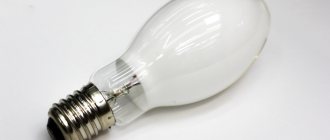Electrician in the house
Encyclopedia about electricity from A to Z
Masters catalog
Find the best master or company in your city
Bathroom lighting for shower stall
Calculating the lighting of a bathroom if it has a shower stall has its own nuances. After all, usually Soviet bathrooms do not require the presence of such large products, and the light bulbs above the entrance to the bathroom are not enough to illuminate the stall.
In this regard, the question arises: how to create additional lighting directly above the shower stall. This question is especially relevant when the ceilings of the room are low and any lamps located above the shower will be located unacceptably close to the water flow.
- Requirements for bathroom electrical equipment
- Lighting in the bathroom for the shower stall 12 V network for lighting the shower stall
- Increasing general bathroom lighting
No. 1. How many lamps will be needed?
The number of lighting fixtures in the bathroom depends directly on its area . If the room is very tiny , and its area is about 5 m2, then a chandelier in the center of the ceiling with two or three lamps will be enough. But even if the bathroom is small, it is better to additionally illuminate the washbasin and mirror area to make all cosmetic procedures much easier.
If the bathroom is spacious enough , then it is necessary to provide zone lighting, the features of which will depend on the configuration of the room, design ideas and some other factors.
It is important to consider a lot of other factors that affect the lighting in the bathroom. These include:
- interior style , or rather the chosen color scheme, because, as you know, light shades reflect light fluxes more, which means the room will seem more illuminated. The same can be said about glossy, mirror and glass surfaces;
- the height at which the lamps will be installed , because the closer they are to a person, the brighter the light they give;
- type of lamps.
It is better to decide on the number and location of lighting fixtures at the stage of repair work in order to avoid unnecessary hassle and waste in the future.
Installation rules
It is not recommended to install spotlights in the immediate vicinity of the bathtub, even if they are ceiling mounted and, it would seem, sufficiently far from the water. The safe zone should be about 60 cm - to the side of it, and at least one and a half meters up. Only low-voltage ceiling models with a high airtightness index (IP no less than 66) are allowed here. But still, choose a rotating spot better, and move it slightly to the side of the bath (at a distance of about 60 cm), pointing the lampshade in the direction you need. In the shower, it is generally more appropriate to use low-voltage lighting systems (the same halogen or LED), since even if a short circuit occurs, the negative consequences for health will be minimal. It should be remembered that all additional components, such as wires, power supply, dimmer, step-down transformer, sensors, must be waterproof. Even taking into account that the ceiling coating mechanically protects them from splashes, the condensation that constantly forms can still lead to oxidation of the contacts, and as a result, to breakdown. If you plan to install the lamps yourself, be sure to lay the wire in a corrugated sleeve. When assembling the chain, it is advisable to solder all the twists, then wrap them with electrical tape or cover the joints with heat-shrink tubing. Better yet, use special clamp terminals. They are much easier to work with, plus, when the need arises to replace one of the bulbs, you simply unfasten the old one and attach a new one. And there is no need to extend the cables and re-solder the circuit.
No. 2. What type of lamp should I choose?
Today, the choice of lighting devices is so extensive that everyone can choose the option that best suits their wishes. So, according to the type of location on the surface, lamps can be:
- open;
- built-in This option is preferable for miniature bathrooms with not very high ceilings.
Depending on the location, the lamps can be:
- ceiling _ This is a timeless classic. Each bathroom should be equipped with at least one ceiling lamp, which will be responsible for the general light in the room;
- wall- mounted These are lamps that are designed to highlight certain functional areas of the room;
- floor lamps perform more of a decorative function; they can add zest to the interior of a room and visually expand the space of the room.
Each of the lamps used can perform one or several of the following functions :
- work lighting;
- decorative lighting;
- directional lighting;
- general lighting.
, different types of lamps can be used as light sources :
- incandescent lamps;
- halogen;
- luminescent;
- LED
Everyone has the right to choose the type of lamps themselves, depending on the type of lamp or their own desire to save money, but special attention should be paid to LED lamps . They are considered the most economical and safe, because they do not heat up during operation. LED strip is also often used , which brings real zest to the bathroom interior. The only drawback of LED lamps is their high price.
Examples
Spots can be either the usual round or square. The latter look very fresh and harmonize perfectly with the mosaic decoration on the walls.
Design example
For a small shower room, a couple of built-in spots are enough. As you can see in the photo below, the rule of placing the lamps at some distance from the bathtub was followed so that the steam would not envelop them in a column. However, if the ceilings are high, this rule can be neglected, the main thing is that the lamps have a high protection class.
Design example
The spots located in parallel - on the ceiling and on the floor - look original. The symmetry created in this way creates an image of completeness and integrity of the interior.
Spots on the floor
It would be ideal to provide the ability to turn on separate lighting units on the floor and ceiling using switches with several keys.
Dotted “eyes,” in addition to their direct purpose, also allow you to emphasize the unusual geometry of the ceiling box. Although modern design trends are gradually moving away from overly complex designs.
Spotlights
To get an elegant ceiling, use lamps with prismatic shades. Light, scattering through multidirectional prisms, creates unimaginable patterns.
Prismatic shades
When changing lampshade rings, the unusual ceiling ornament formed by such lamps will diversify the look of the room.
If the tiles in the shower are glossy, consider that the plane of each wall will double the number of fixtures - due to reflection.
However, this effect is not always pleasing to the eye. Therefore, it is better to choose models with a movable mechanism in order to adjust the direction of the light flux during use so that glare does not cause you discomfort.
Or you can simply choose a bath with built-in lighting, and not bother with multi-level (or central) lighting for the entire room. A calming atmosphere with complete relaxation is guaranteed. But be prepared for the fact that such a bath costs a lot.
Bathtub with built-in lighting
However, the problem of creating dim light is solved by using a dimmer. And you don’t even have to leave the bath - many manufacturers supply models equipped with mini remote controls. Of course, they must be sealed so that you can safely take them with wet hands - without the risk of a short circuit. Only such systems cannot be used in conjunction with fluorescent lamps - they do not tolerate frequent switching on, and take too long to gain potential to start.
Built-in ceiling lights still remain relevant today. They easily “get along” with different types of interiors and are suitable for any room, even a bathroom, with unfavorable conditions for the operation of electronics. With them, the scope for creativity, for the sake of user comfort, is simply limitless.
No. 3. How to properly place light sources in the bathroom?
choosing the location of lighting fixtures in the bathroom very carefully Experience suggests that you need to take into account some nuances , including:
- lighting must be uniform , so you should always take into account the following rule. The more light sources in the room, the lower their power should be;
- light should be properly distributed, and lamps should be located in all functional areas of the bathroom;
- it is important to avoid glare , and for this you should not direct the lamps perpendicular to reflective surfaces: it is better if they are located at an angle;
- A common mistake is to place one lamp directly above the mirror. Often in this case the reflection will be slightly distorted. It is better to use mirror lighting on the sides, or top and sides;
- zest can be added to the interior thanks to color spots : colored lampshades, original ceramic tile inserts. But it is better not to place such details in the area of the mirror, so as not to distort the reflection;
- Those who like non-standard ideas can be advised to experiment with the location of the LED strip: it can be placed under the side of the bathtub, under the window sill, etc.;
- It is better to connect different lamps in the bathroom using separate lines , because not every time you will need to turn on all the lighting at once.
Connecting point models
Twelve-volt light models are connected via a transformer. The connection is parallel. To calculate the number of sources, you need to find out the power of the transformer.
Conversely, purchasing a transformer begins with calculating the number of point sources and finding out their power. The transformer power is calculated with a reserve.
No. 4. The need for ceiling lighting
As already mentioned, one source of lighting is not enough even in the smallest bathroom. The function of general lighting is usually performed by ceiling lamps, which must be present in the bathroom. So, for ordinary ceilings it is better to choose a chandelier, and for pendant ceilings you can use recessed lamps. It is also worth considering the height of the room, and do not place long chandeliers in low rooms. An excellent option is a spotlight lamp , the direction of the light of which can be adjusted to obtain a sufficient level of illumination in any area of the room.
The shape, design and color of lighting fixtures can be very different, and here the choice should be based on personal preferences, the design of the room, but not forgetting about functionality.
No. 5. What functional areas should be highlighted in the bathroom?
If your bathroom is quite spacious, then you need to select several zones with their own lighting:
- wash area, where, naturally, the washbasin and mirror are located;
- bathing area with bath or shower;
- a free area for changing clothes, folding things or doing laundry.
In addition, pieces of furniture can also be illuminated : shelves, cabinets, bedside tables can have small built-in lamps that provide soft, unobtrusive light that can illuminate the entire contents of the cabinet and make it easier to find the necessary item.
No. 6. Mirror and washbasin lighting
The mirror needs to be illuminated so that the reflection in it is as natural as possible, without unnecessary shadows and does not distort the colors. In this case, it is better to refuse lamps under the mirror, as well as colored lighting, which will create unnecessary color spots on your reflection. It is better if the light is as soft as possible , so the lampshades can be matte or white. The best option is to place light sources on the sides or along the perimeter of the mirror. Lamps can be used of absolutely any type, but it is better that the resulting light is as close as possible to natural daylight.
Transformers
When buying lamps, pay attention to transformers. Deciding on a suitable model is quite simple. To do this, you need to multiply the power by the number of lamps used. The result obtained will indicate the required power that your transformer will have. Very often, a new transformer is used for each new group of light bulbs. This solution will help prevent possible negative consequences of transformer breakdowns, when the light can disappear at any moment. And when several transformers are operating, even if one fails, the others will work properly.
No. 7. Bath or shower lighting
Bathroom lighting is not mandatory; rather, it serves a purely decorative role , creating a cozy and relaxing atmosphere. So, you can find several lamps in the shower, hang several sconces above the bathtub, or even organize bottom lighting in the bathtub. Everyone has long known that taking a bath is more of a relaxation than a hygienic procedure, and appropriate lighting can make such a relaxation even more comfortable.
No. 8. Possibilities of decorative lighting
For fairly spacious bathrooms with interesting architectural details, you can use lighting that does not have any direct function, but is intended only to decorate the interior and create a unique atmosphere. You can highlight anything: steps, niches, windows, other elements of the room . Today there are even tiles that have LEDs built into them.
Separately, it should be noted floor lighting : to create it, durable lamps are used, such as for garden paths, and their power should be no more than 5 W. With their help, you can create a unique interior and visually expand the boundaries of the bathroom.
No. 9. Safety regulations
Where electricity and humidity meet, there is an increased risk of unforeseen conditions that can be dangerous. That is why when choosing, installing and using lighting fixtures in the bathroom you need to adhere to a number of rules:
- correctly develop a bathroom lighting scheme, and this task can be entrusted to professionals;
- It is necessary to use only those lamps that are resistant to moisture;
- metal parts of lamps must be protected from corrosion;
- lighting fixtures in the bath and shower should have a power of no more than 12 W;
- You cannot place sconce lamps directly above the bathroom;
- The risk of water entering wall or ceiling lighting fixtures should be minimal. There is no place for open incandescent lamps in the bathroom at all, since if drops of water get on the heated glass, the lamp may even burst, and glass fragments will scatter throughout the room;
- There is no place for exposed wiring, extension cords, or tees in the bathroom.
Features of choice
It is the ceiling types of lamps that are most often chosen to illuminate a room such as a bathroom. They, in turn, can be mounted in a suspended ceiling made of plasterboard, slatted or suspended ceiling. The lighting from them is uniform and suitable for illuminating even large rooms. The outer part of these types of lamps can be movable, which makes it possible to direct the rays of light in the direction you need. Another advantage of such lamps is ample opportunities for designers who work on creating an interior.
What you should pay attention to when going shopping for lamps:
- Safety. This is due to the fact that the bathroom is an area of high humidity, so when buying a lamp, check how protected it is from dust and moisture. There is an IP code specifically for this. If you don’t find it on the lamp, then you can safely put it aside and look for another one. The safety level is indicated by the second digit in the product labeling. The higher it is, the closer to the water source it can be placed.
- Brightness. The quality of your shaving or makeup will depend on this. To ensure that the lighting does not let you down, consider the power of the lamps. For standard lamps it is 20-30 W/m2. For halogen lamps this figure is 23-28 W/m2. But for fluorescent lamps it is no more than 6-9 W/m2.
- Design. The choice of lamp should be based on the style in which your room is designed.
https://youtube.com/watch?v=swVvX0W_lTc
In conclusion
Bathroom lighting is a detail that performs several functions at once, and therefore the approach to organizing lighting requires taking into account a variety of factors: the type and power of the lighting fixture, location, safety, design, etc. With all this, it is important not to forget about safety precautions both at the stage of repair work and in the future. Remember that thanks to lighting you can create not only a comfortable, but also a cozy space.
The article was written for the site.
Tags:Bathroom, Lighting systems
